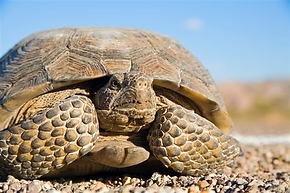December 21, 2017 | News | New Database
Which animals age, and how do they age?

The mortality of the gopher tortoise (Gopherus agassizii) decreases steadily with age. © © iStockphoto.com/Wild Roses Images
A new database that collects data on the aging of various animal species goes online today. The open-access database is a valuable resource for researchers who study aging.
DATLife, an open-access database maintained at the MPIDR, makes freely available data on aging in a wide range of animal species. These high-quality data enable researchers to study the phenomenon of aging – some aspects of which remain puzzling even today.
We are born, we grow up, we reproduce, we grow older, and – at some point – we die. Living creatures the world over experience this cycle. But whereas for some species this cycle is completed in just a few days, for others it unfolds over several centuries. Yet it is not only maximum age that varies from species to species; but the way in which aging occurs. For example, for some species, including humans, mortality – or the probability of dying within the next year of life – increases steadily towards the end of life. This is not, however, a regular pattern that applies to all species according to data that researchers in Rostock have collected. For example, the mortality of the gopher tortoise (Gopherus agassizii), which lives in the deserts of the southern United States and northern Mexico, decreases steadily with age. In other words: the older the tortoise gets, the less likely it is to die.
These data call into question widely accepted theories of aging: “The conventional theories about aging predict that after an animal reaches sexual maturity, mortality should increase and the ability to reproduce should decrease,” explained MPIDR scientist Alexander Scheuerlein, who initiated the database and set it up together with his MPIDR colleague Dirk Vieregg and more than twenty student helpers.
In an article published in 2013 in the journal Nature, Scheuerlein and colleagues showed data on mortality and fertility trajectories of 43 species of plants and animals. “Only a small fraction of the species displayed a mortality pattern that fits these theories; that was the impetus behind our decision to set up the DatLife database,” Alexander Scheuerlein said. “Scientists need these data to research the phenomenon of aging more thoroughly.”
The database consists of data on age-specific mortality of more than 250 species, and, eventually age-specific fertility. In addition, it holds data on life expectancy of 700 species, data on the maximum observed lifespan of more than 3,000 species, and data on the age at sexual maturity in more than 2,800 species. All of the data included in the database have appeared in peer-reviewed journals, and have been carefully checked, and eventually recalculated, by database staff. For each dataset, information is provided on the location of the study, and about the length and the end date of the study. Moreover, the number of individuals that were investigated is recorded, which allows eighting of the data: i.e., studies that included larger numbers of individuals are assigned different values than studies with smaller samples of animals.
While compiling the data was a laborious task for the researchers and their assistants, this process also provided interesting insights into how difficult the collection of the original data must have been. For example, the scientific community owe the data on the gopher tortoise mentioned above to an environmental project, intended to assess the possible impact of the development of solar, wind, and geothermal energy sources in California. As part of a assessment of the potential environmental effects, a large amount of money was made available to study the tortoise populations. This funding enabled researchers to use huge mobile x-ray machines to x-ray the tortoises in the desert in order to determine how many eggs they were carrying.
However, another study that investigated the life span of the Wandering Albatros (Diomedea exulans) was revealed to have been a researcher’s life-long project that came to a premature end. In the literature, the maximum life span of this bird has always been reported as being 40 years. But when they looked at the original article that cited this figure, Scheuerlein and his colleagues found that the study ended after the researcher had spent 40 long years observing the albatros – but what age the albatros actually reached is anybody’s guess.
“The previous theories are probably too simple, and it is likely that the aging process is much more varied than has previously been assumed,” Alexander Scheuerlein said.
Some attempts have been made in the past to explain variations in the aging process. One possible explanation is that each species has to make different evolutionary compromises. For example, the “grandmother hypothesis” provides an evolutionary explanation for why humans and other social animals continue to live long after their reproductive life span has ended. According to this theory, the chances of producing offspring decline sharply in these animals because it pays off more for them to invest in grandchildren than in their own reproduction.
The database will be expanded over time. In particular, the database will be augmented with data on insect species.
More Information
DATLife - Homepage of the database